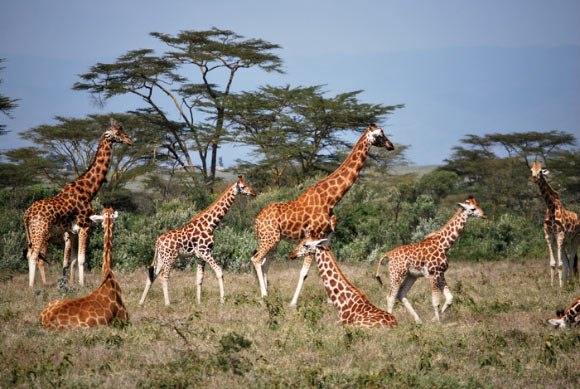
Giraffes are Socially Complex Animals, Says New Review
Giraffes (Giraffa camelopardalis) exhibit many of the features typical of mammals with complex cooperative social systems and matrilineal societies, according to a review paper published in the journal Mammal Review.
Giraffes are the tallest living terrestrial animals, the largest extant ruminants, and conspicuous members of the African fauna.
Until the 2000s, they were believed to have no social structure, largely because of the daily fluidity in their group composition.
Although it is now well established that giraffe social organization is non-random, there is little consensus as to what influences preferred and avoided associations or the underpinning mechanisms.
“We tested two hypotheses: first, giraffes have a complex cooperative social system, exhibited by (i) stable groups of females, (ii) offspring that stay in their natal group for part or all of their lives, (iii) support by non-mothers in rearing young, and (iv) non-reproductive females in the group,” said University of Bristol researchers Zoe Muller and Professor Stephen Harris.
“And second, giraffes form matrilineal societies, evidenced by (i) male dispersal, (ii) female philopatry, (iii) assistance in raising or protecting offspring, and (iii) individual benefits gained from social foraging.”
The authors reviewed 404 papers on giraffe behavior and social organization.
Their results show that giraffes spend up to 30% of their lives in a post-reproductive state.
This is comparable to other species with highly complex social structures and cooperative care, such as elephants and killer-whales which spend 23% and 35% of their lives in a post-reproductive state respectively.
In these species, it has been demonstrated that the presence of post-menopausal females offers survival benefits for related offspring.
In mammals, including humans, this is known as the ‘Grandmother hypothesis’ which suggests that females live long past menopause so that they can help raise successive generations of offspring, thereby ensuring the preservation of their genes.
The researchers propose that the presence of post-reproductive adult female giraffes could also function in the same way, and supports their assertion that giraffes are likely to engage in cooperative parenting, along matrilines, and contribute to the shared parental care of related kin.
“It is baffling to me that such a large, iconic and charismatic African species has been understudied for so long,” Muller said.
“Our paper collates all the evidence to suggest that giraffes are actually a highly complex social species, with intricate and high-functioning social systems, potentially comparable to elephants, cetaceans and chimpanzees.”
“I hope that this study draws a line in the sand, from which point forwards, giraffes will be regarded as intelligent, group-living mammals which have evolved highly successful and complex societies, which have facilitated their survival in tough, predator-filled ecosystems.”
“Recognizing that giraffes have a complex cooperative social system and live in matrilineal societies will further our understanding of their behavioral ecology and conservation needs,” she added.
“Conservation measures will be more successful if we have an accurate understanding of the species’ behavioral ecology.”
“If we view giraffes as a highly socially complex species, this also raises their ‘status’ towards being a more complex and intelligent mammal that is increasingly worthy of protection.”
